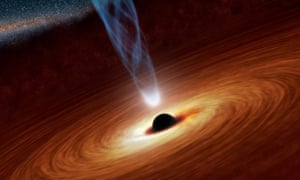Extract from The Guardian
Scientists observing V404 Cygni discovered that
even amateur telescopes are capable of capturing violent outburst
from black holes closest to Earth
A Nasa illustration of a supermassive black hole.
Before the V404 Cygni observations, similar outbursts had only been
seen as intense flashes of x-rays and gamma-rays, using high-spec
telescopes.
Photograph: Nasa/Reuters
Photograph: Nasa/Reuters
Ian
Sample Science editor
Thursday 7 January 2016 05.41 AEDT
Astronomers have discovered that black holes can
be observed through a simple optical telescope when material from
surrounding space falls into them and releases violent bursts of
light.
The apparent contradiction emerges when a black
hole’s gravity pulls in matter from nearby stars, producing light
that can be viewed from a modest 20cm telescope.
Japanese researchers detected light waves from
V404 Cygni - an active black hole in the constellation of Cygnus, the
Swan - when it awoke from a 26-year-long slumber in June 2015.
Writing in the journal Nature,
Mariko Kimura of Kyoto University and others report how telescopes
spotted flashes of light coming from the black hole over the two
weeks it remained active. The flashes of light lasted from several
minutes to a few hours. Some of the telescopes were within reach of
amateur astronomers, with lenses as small as 20cm.
“We now know that we can make observations based
on optical rays - visible light, in other words - and that black
holes can be observed without high-spec x-ray or gamma-ray
telescopes,” Kimura said.
The black hole, one of the closest to Earth, has a
partner star somewhat smaller than the sun. The two objects circle
each other every six-and-a-half days about 8,000 light years from
Earth.
Black
holes with nearby stars can burst into life every few decades. In
the case of V404 Cygni, the gravitational pull exerted on its partner
star was so strong that it stripped matter from the surface. This
ultimately spiralled down into the black hole, releasing a burst of
radiation. Until now, similar outbursts had only been observed as
intense flashes of x-rays and gamma-rays.
At 18.31 GMT on 15 June 2015, a gamma ray detector
on Nasa’s
Swift space telescope picked up the first signs of an outburst
from V404 Cygni. In the wake of the event, Japanese scientists
launched a worldwide effort to turn optical telescopes towards the
black hole.
The flickers of light are produced when x-rays
released from matter falling into the black hole heat up the material
left behind.
Poshak
Gandhi, an astronomer at Southampton University, said the black
hole looked extremely bright when matter fell in, despite being
veiled by interstellar gas and dust. “In the absence of this veil,
V404 Cygni would have been one of the most distant objects in the
Milky Way visible in dark skies to the unaided eye in June 2015,”
he writes in the journal.
A Nasa animation demonstrates how a star would be
ripped apart if it got too close to a black hole in space.
The discovery comes a day after astronomers
reported two massive blasts of gas coming from a supermassive
black hole in the heart of a galaxy 26 million light years away.
Scientists believe that two arcs of x-rays spotted by Nasa’s
Chandra X-ray Observatory at the heart of the spiral galaxy, NGC
5195, are the remnants of huge outbursts of gas from the black
hole.“Astronomers often refer to black holes as eating stars and
gas. Apparently, black holes can also burp after their meal,” said
Eric Schlegel who led the study at the University of Texas in San
Antonio. “It is common for big black holes to expel gas outward,
but rare to have such a close, resolved view of these events.”
Christine Jones, a co-author at the
Harvard-Smithsonian Center for Astrophysics in Cambridge,
Massachusetts, said: “We think these arcs represent fossils from
two enormous blasts when the black hole expelled material outward
into the galaxy. This activity is likely to have had a big effect on
the galactic landscape.” The eruptions of gas are thought to have
been triggered by the smaller galaxy, NGC 5195, merging with its
larger neighbour, the Whirlpool
galaxy. The merging process drove gas towards the black hole and
the material released energy as it fell inside. As the hot,
x-ray-emitting gas poured outwards, it swept up colder hydrogen from
the galaxy’s centre like a snowplough.
The work was presented at the annual meeting of
the American Astronomy
Society in Florida.

No comments:
Post a Comment